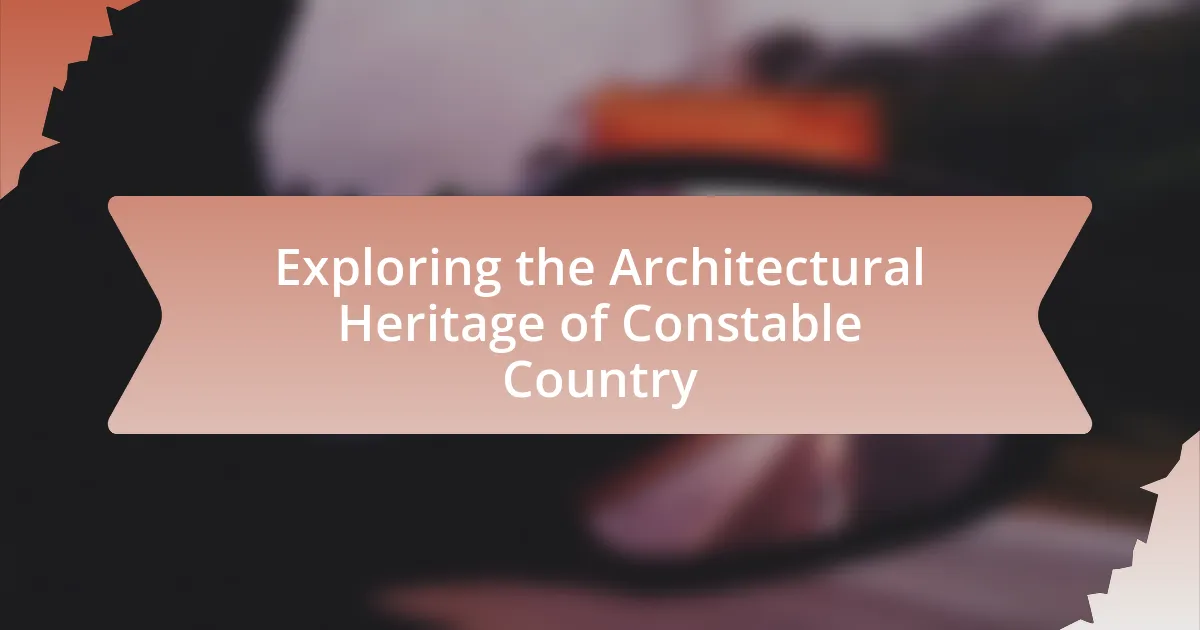The architectural heritage of Constable Country is characterized by traditional English buildings, including timber-framed houses, churches, and barns that reflect the region’s rural identity. Key historical structures, such as the 14th-century St. Mary’s Church in Dedham and Flatford Mill, exemplify the vernacular architecture influenced by local materials and socio-economic conditions. The evolution of architectural styles in the area, shaped by movements like Romanticism and Georgian architecture, highlights the significance of these buildings in preserving cultural identity and historical continuity. The article also addresses the challenges facing this heritage, including environmental threats and urban development pressures, while emphasizing the importance of preservation for local tourism and community pride.

What is the Architectural Heritage of Constable Country?
The architectural heritage of Constable Country primarily consists of traditional English buildings, including timber-framed houses, churches, and barns that reflect the rural character of the area. Notable examples include the 14th-century St. Mary’s Church in Dedham and the historic Flatford Mill, which showcase the vernacular architecture typical of the Suffolk and Essex landscape. These structures are significant not only for their aesthetic value but also for their historical context, as they represent the agricultural and social history of the region, which inspired the famous painter John Constable in the 19th century.
How did Constable Country’s architecture develop over time?
Constable Country’s architecture developed over time through a blend of local materials, traditional building techniques, and influences from broader architectural movements. Initially, the region featured vernacular styles characterized by timber-framed houses and thatched roofs, reflecting the agricultural lifestyle of its inhabitants. As the 18th and 19th centuries progressed, the influence of the Georgian and Victorian architectural styles became evident, leading to the construction of more formal structures, such as brick houses and public buildings, which showcased symmetry and decorative elements. This evolution was further influenced by the Romantic movement, which emphasized the picturesque qualities of the landscape, as seen in the works of artist John Constable, who celebrated the rural architecture in his paintings. The preservation of these architectural styles today highlights the historical significance and cultural heritage of Constable Country.
What historical influences shaped the architectural styles in Constable Country?
The architectural styles in Constable Country were shaped primarily by the agricultural practices and the socio-economic conditions of the 18th and 19th centuries. The region’s rural landscape influenced the construction of timber-framed houses and farm buildings, reflecting the local materials and craftsmanship. Additionally, the Romantic movement, which emphasized nature and rural life, inspired the picturesque designs seen in the area, as artists like John Constable celebrated the beauty of the countryside. The prevalence of Georgian architecture during this period also contributed to the aesthetic, with its symmetry and classical proportions evident in many structures.
How do local materials and geography impact the architecture?
Local materials and geography significantly influence architecture by dictating the available resources and design adaptations necessary for environmental conditions. In Constable Country, for instance, the abundance of local clay has historically led to the use of brick in construction, while the region’s rolling hills and river valleys have shaped building orientations and styles to harmonize with the landscape. This relationship is evident in the vernacular architecture, where structures are often designed to withstand local weather patterns and utilize materials that provide thermal efficiency, such as thatch and timber, which are readily available. The integration of these elements not only reflects the cultural identity of the area but also ensures sustainability and resilience in the built environment.
What are the key architectural features found in Constable Country?
Key architectural features found in Constable Country include traditional timber-framed houses, red brick buildings, and picturesque churches. These structures often reflect the rural vernacular style, characterized by steeply pitched roofs and large chimneys. Notable examples include the 14th-century St. Mary’s Church in Dedham and the historic buildings in Flatford, which showcase the region’s connection to the artist John Constable. The use of local materials and the integration of buildings with the surrounding landscape further emphasize the area’s architectural heritage.
What types of buildings are most prevalent in the region?
The most prevalent types of buildings in Constable Country are traditional timber-framed houses and historic churches. These structures reflect the region’s architectural heritage, with timber-framed houses dating back to the 15th century, showcasing the craftsmanship of that era. Additionally, notable churches, such as St. Mary’s Church in Dedham, exemplify the Gothic architectural style and contribute to the historical landscape, reinforcing the area’s cultural significance.
How do these features reflect the cultural identity of Constable Country?
The features of Constable Country, including its picturesque landscapes, traditional architecture, and agricultural practices, reflect the cultural identity of the region by embodying the historical and artistic legacy of John Constable. The rural scenery, characterized by rolling hills, rivers, and quaint villages, has inspired numerous paintings that celebrate the local environment and community life. This connection to Constable’s work reinforces a sense of pride and continuity in the local culture, as the landscapes depicted in his art remain largely unchanged, preserving the region’s heritage. Additionally, the preservation of historic buildings and farming methods highlights the community’s commitment to maintaining its cultural roots and identity, showcasing a blend of natural beauty and human craftsmanship that defines Constable Country.
Why is the preservation of architectural heritage important?
The preservation of architectural heritage is important because it maintains cultural identity and historical continuity. Architectural heritage serves as a tangible link to the past, reflecting the values, traditions, and artistic expressions of previous generations. For instance, structures like the historic buildings in Constable Country not only showcase unique architectural styles but also contribute to local tourism and community pride. Studies indicate that heritage tourism can significantly boost local economies, with visitors drawn to the historical significance and aesthetic appeal of preserved sites. Thus, preserving architectural heritage is essential for fostering cultural appreciation and economic vitality.
What role does architectural heritage play in local tourism?
Architectural heritage significantly enhances local tourism by attracting visitors interested in historical and cultural experiences. In Constable Country, the presence of well-preserved buildings and landscapes, such as those depicted in John Constable’s paintings, draws tourists who seek to engage with the region’s artistic and historical significance. According to a study by the Heritage Lottery Fund, heritage tourism contributes approximately £4.1 billion annually to the UK economy, highlighting the economic impact of architectural heritage on local communities. This influx of visitors supports local businesses, creates jobs, and fosters community pride, thereby reinforcing the importance of architectural heritage in promoting tourism.
How does preservation contribute to community identity and pride?
Preservation contributes to community identity and pride by maintaining historical landmarks and cultural heritage that reflect the unique character of a community. In Constable Country, the preservation of architectural sites, such as traditional cottages and historic churches, fosters a sense of belonging and continuity among residents. This connection to the past enhances community pride, as evidenced by local initiatives that celebrate these sites through events and educational programs, reinforcing the community’s distinct identity. Studies show that communities with preserved heritage sites often experience increased social cohesion and local engagement, further solidifying their unique identity and pride.
How can one explore the architectural heritage of Constable Country?
One can explore the architectural heritage of Constable Country by visiting key historical sites and engaging in guided tours that highlight the region’s unique structures. Notable locations include the picturesque villages of Dedham and Flatford, where visitors can see traditional timber-framed houses and the iconic Flatford Mill, which dates back to the 18th century. Additionally, walking trails such as the Dedham Vale AONB (Area of Outstanding Natural Beauty) provide access to various architectural landmarks while immersing visitors in the scenic landscape that inspired artist John Constable. These sites collectively showcase the rich architectural history and cultural significance of the area, making it an ideal destination for heritage exploration.
What resources are available for learning about Constable Country’s architecture?
Resources available for learning about Constable Country’s architecture include books, online articles, and guided tours. Notable books such as “Constable Country: The Landscape of John Constable” by David Blayney Brown provide in-depth analysis and visual references to the architectural styles in the region. Online platforms like the National Trust website offer articles and resources detailing the historical significance and architectural features of the area. Additionally, guided tours organized by local heritage organizations allow visitors to explore and learn about the architecture firsthand, enhancing understanding through expert commentary.
What local organizations focus on the preservation of architectural heritage?
Local organizations that focus on the preservation of architectural heritage in Constable Country include the Constable Country Landscape Partnership and the Suffolk Preservation Society. The Constable Country Landscape Partnership works to conserve the unique landscape and heritage of the area, which is closely tied to the works of artist John Constable. The Suffolk Preservation Society actively campaigns for the protection of historic buildings and landscapes throughout Suffolk, providing resources and support for local heritage initiatives. Both organizations play a crucial role in safeguarding the architectural heritage of Constable Country through various conservation projects and community engagement efforts.
How can visitors engage with the architectural sites in Constable Country?
Visitors can engage with the architectural sites in Constable Country by participating in guided tours, exploring heritage trails, and attending local events. Guided tours provide in-depth knowledge about the historical significance and architectural features of sites like Flatford Mill and Dedham Church. Heritage trails, such as the Constable Country Walk, allow visitors to experience the landscape that inspired John Constable while discovering various architectural landmarks along the route. Additionally, local events, including art exhibitions and historical reenactments, offer interactive experiences that enhance understanding and appreciation of the region’s architectural heritage.
What are the challenges facing the architectural heritage of Constable Country?
The architectural heritage of Constable Country faces several challenges, including environmental degradation, urban development pressures, and inadequate funding for preservation. Environmental factors, such as climate change, threaten the structural integrity of historic buildings, while urban development often prioritizes new construction over the conservation of existing heritage sites. Additionally, funding for maintenance and restoration is frequently insufficient, leading to deterioration of important architectural features. These challenges collectively jeopardize the preservation of Constable Country’s unique architectural identity, which is integral to its cultural and historical significance.
How do modern developments threaten historical structures?
Modern developments threaten historical structures primarily through urbanization, which often leads to the demolition or alteration of these sites. For instance, construction projects may encroach upon or overshadow historical buildings, compromising their visibility and context. Additionally, the use of incompatible materials and architectural styles in new developments can detract from the aesthetic integrity of historical sites. Research indicates that in areas like Constable Country, increased tourism and infrastructure expansion have resulted in significant pressure on local heritage sites, leading to potential degradation and loss of historical value.
What strategies are being implemented to address these challenges?
Strategies being implemented to address the challenges in exploring the architectural heritage of Constable Country include conservation efforts, community engagement, and educational initiatives. Conservation efforts focus on preserving historical buildings and landscapes through restoration projects and protective legislation, ensuring that the architectural integrity is maintained. Community engagement involves local stakeholders in decision-making processes, fostering a sense of ownership and responsibility towards heritage sites. Educational initiatives aim to raise awareness about the significance of Constable Country’s architecture, promoting its history and cultural value through workshops, guided tours, and informational resources. These strategies collectively enhance the preservation and appreciation of Constable Country’s architectural heritage.
What practical tips can enhance the experience of exploring Constable Country’s architecture?
To enhance the experience of exploring Constable Country’s architecture, visitors should consider taking guided tours that focus on the historical context and architectural details of the area. These tours often provide insights into the significance of structures like Flatford Mill and Dedham Church, which are integral to the landscape that inspired John Constable’s paintings. Additionally, utilizing local maps that highlight key architectural sites can help visitors navigate efficiently and appreciate the connections between the buildings and the surrounding natural beauty. Engaging with local historians or participating in workshops can further deepen understanding of the architectural styles prevalent in the region, such as Georgian and Victorian influences.

